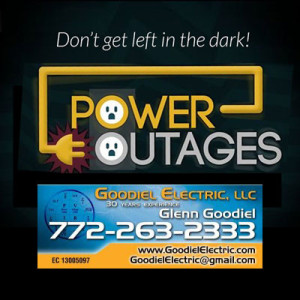May 10 2016
Load Testing Standby Generators
Load testing for reliability.
 The rational for a Treasure Coast homeowner to install and maintain a standby generator is that a reliable source of electrical power will be available in the event of an emergency. Insuring that reliability depends on load testing.
The rational for a Treasure Coast homeowner to install and maintain a standby generator is that a reliable source of electrical power will be available in the event of an emergency. Insuring that reliability depends on load testing.
How reliable is a homeowner’s on-site power system? Waiting until an outage occurs is not the time to find out. The better way is to periodically test the standby generator under load to help ensure it is ready to run when needed.
Homeowners may be reluctant to test the standby generators, transfer switch, and other components under load because of cost or inconvenience. If the testing reveals a problem, then what? However, there are several very important reasons to test the on-site power system.
Why load testing.
A standby generator that is idle most of the time needs to be exercised to prevent the system from breaking down due to lack of use. Testing helps to pro-actively diagnose and fix problems and determine if an aging standby system is due for replacement or component upgrades — at a time the system is not needed.
Testing a generator with a load bank eliminates the effects of wet stacking. Wet stacking is the build-up of carbon deposits in the exhaust. This build-up can adversely impact generator components including piston rings, turbochargers, injector nozzles, the combustion chamber and the exhaust pipe. Running the generator at the required percentage of the rated load burns off carbon deposits in the engine.
The technicians conducting the load testing will also monitor the engine for leaks, temperature and oil pressure loss. Based on their observations and readings, they can be ready to disconnect the load if problems arise.
Ultimately, the cost of regularly scheduled maintenance and testing is worth the insurance that a well maintained standby generator provides.
How to load test.
The safest and most efficient way to evaluate the health of a standby power system is to schedule periodic field testing of the standby generator and its associated components under the equivalent of a live load. The test should be conducted by qualified technicians under controlled conditions.
Turning on a generator without a load attached is like turning on the ignition in a car left up on jacks in a garage for a long time. There is no way to know if the vehicle will operate on the road. Just hearing the motor run doesn’t mean the car can be driven or the tires are aligned.
Load testing is typically done by applying an outside electrical load to the standby generator. The load bank, which is generally portable and transported to the facility on a flatbed trailer or the back of a truck, is equal to the total load the generator would be expected to carry if utility power became unavailable. This type of test does not disturb the live load and eliminates the risk of causing a loss of power should the system not function as intended.
Once the load bank is connected to the standby generator, the generator is turned on and operated for a predetermined period of time. The attending technicians make note of any operational problems, which the homeowner can then address at a non-critical time.
When to load test.
How often the testing should occur depends on the classification or use of the facility, local building code, the original equipment manufacturer’s recommendations for the application, and operating conditions.
While some homeowners may balk at the cost of load testing, the expense is substantially less than the costs of an unexpected outage. Scheduling periodic field testing and pro-actively diagnosing and fixing problems when the standby generator isn’t needed will help ensure a homeowner isn’t left in the dark when the generator is needed.
Would you like a complimentary…no obligation …project consultation? Please feel free to call for more details.
Goodiel Electric, LLC .
.
Glenn Goodiel.
Mobile: (772) 263-2333.
Skype: (772) 263-2333.
Florida License – EC13005097.
Call Goodiel Electric, LLC. for a Great Deal.
Call master electrician and Martin County based electrical contractor Glenn Goodiel for all your electrical service needs.
 In Martin County, Goodiel Electric, LLC. services Hobe Sound, Indiantown, Jensen Beach, Jupiter Island, North River Shores, Ocean Breeze Park, Palm City, Port Salerno, Rio, Sewall’s Point and Stuart, FL.
In Martin County, Goodiel Electric, LLC. services Hobe Sound, Indiantown, Jensen Beach, Jupiter Island, North River Shores, Ocean Breeze Park, Palm City, Port Salerno, Rio, Sewall’s Point and Stuart, FL.
In St. Lucie County, Goodiel Electric, LLC. services Port Saint Lucie, St. Lucie West, Tradition, Torino, Tesoro, Lake Charles, Lake Forest, Magnolia Lakes, PGA Village, The Vineyards, St James Golf Club, The Cascades, Fort Pierce, and the unincorporated areas of St. Lucie County, FL.





May 17 2017
UL 1008 Transfer Switches for Standby Generators
UL 1008 Transfer Switches Deliver Dependability.
UL 1008 is a standard for transfer switch equipment that was first issued in 1972. It was approved by ANSI in 1976 and has been evolving ever since. A performance standard as well as a design and construction standard, it sets criteria for short circuit testing. UL 1008 is intended to guard against transfer switch failures and resulting fires. It helps ensure the safety of the installation and the safety of the operation and maintenance personnel who work with transfer switch equipment.
Since it was first introduced, there have been several revisions to ensure that transfer switches are adequately tested to safely withstand and close on the short-circuit ratings shown on their labels. Currently in its seventh edition, it is, today, the standard to which switch manufacturers build and test their switches to help ensure they perform as expected.
Labeling UL 1008 Transfer Switches.
Achieving the label UL 1008 requires conforming to a series of rigorous requirements that cover automatic, non-automatic and bypass/isolation transfer switches intended for use in ordinary locations for power and lighting.
The standard sets a series of exacting requirements including:
For example, a transfer switch that has earned UL 1008 certification has the ability to transfer 6,000 times, with one-sixth of those operations at full rated load. That leaves plenty of leeway for a switch that is tested monthly and also might be subjected to a dozen outages of normal power every year.
The seventh edition of UL 1008 became effective as of Nov. 1, 2014. It impacts product shipped on or after that date and resulted in significant changes to the short-circuit ratings shown on all transfer switch products in the industry.
Time-based short circuit and short time ratings are both optional for product qualification under UL 1008. UL 1008 now requires circuit breaker ratings must show short-circuit amperes, voltages, + time duration markings in seconds.
Not every transfer switch manufacturer offers these ratings in addition to the specific breaker rating. However, if a specifying engineer has this added information, that person has more flexibility when selecting an appropriate circuit breaker to coordinate with the desired transfer switch rating. And, after installation, in applications where ratings are relevant, an inspector would look for the additional information.
Would you like a complimentary…no obligation …project consultation? Please feel free to call for more details.
Goodiel Electric, LLC .
.
Glenn Goodiel.
Mobile: (772) 263-2333.
Skype: (772) 263-2333.
Florida License – EC13005097.
Call Goodiel Electric, LLC. for a Great Deal.
Call master electrician and Martin County based electrical contractor Glenn Goodiel for all your electrical service needs.
In St. Lucie County, Goodiel Electric, LLC. services Port Saint Lucie, St. Lucie West, Tradition, Torino, Tesoro, Lake Charles, Lake Forest, Magnolia Lakes, PGA Village, The Vineyards, St James Golf Club, The Cascades, Fort Pierce, and the unincorporated areas of St. Lucie County, FL.
By Glenn_G • Generator Installation, Standby Generators • • Tags: UL 1008 Transfer Switches